Garden Jumping Spider - Opisthoncus parcedentatus
FAMILY SALTICIDAE
This page contains pictures and information about Garden Jumping Spiders that we found in the Brisbane area, Queensland, Australia.

- Body length 8mm
- This jumping spider is common in Brisbane gardens and backyards. They are usually found hunting on board green leaves during the days.



- The Garden Jumping Spider is medium size, brown to orange-brown in colours with white patterns through out the whole body. The larger spiders usually darker in colour. Patterns may be vary between individuals.






- Garden Jumping Spiders do not too concern if we watch them very closely. Usually they will raise their head and look back to us with their large eyes.
-
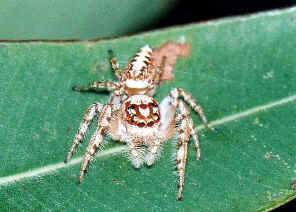


- Male ?
- The spider in the above two photo could be a male. The rest in this page most likely are female. Males have slender abdomen and larger pedipalp. As most other spiders, females are more commonly seen than males.


- Jumping Spider hunts by jumping onto its prey, usually from a higher leaf to a lower leaf. The spider can even capture a flying target. The above pictures show the Jumping Spiders captured a small fly and a Flower Spider.



- Jumping Spider can easily walk on the bottom side of a waxy leaf without any problem.

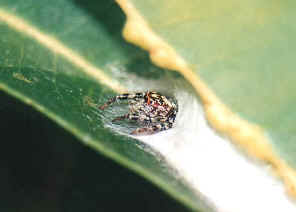

- Garden Jumping Spiders build retreat between leaves or by partly rolling a leaf with silk. Their retreats usually have opening at both ends. They hide in their retreats at night and during winter.
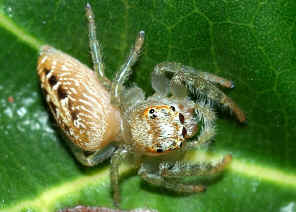
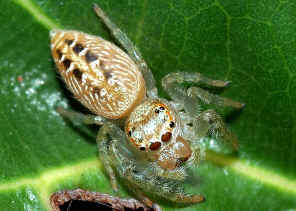

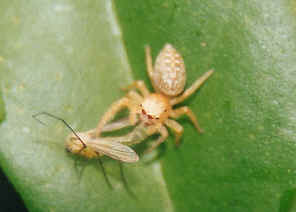

- Jumping Spiders hunt by their vision during the day time. This Jumping Spider just captured a mosquito.
-

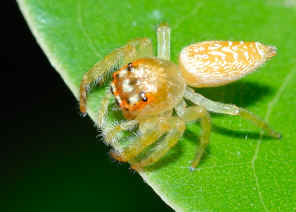
- The Garden Jumping Spiders body colour vary from orange-yellow to brown. The smaller size spiders are paler in colour. It seems that the spiders become darker and darker when growing up.
- Reference:
- 1. Jumping spider Opisthoncus sp. - The Find-a-spider Guide for Australian Spiders, University of Southern Queensland, 2007.
- 2. Jumping spider Opisthoncus parcedentatus - The Find-a-spider Guide for Australian Spiders, University of Southern Queensland, 2008.
- 3. Salticidae Jumping Spiders - Spiders of Australia, Ed Nieuwenhuys, 2009.
- 4. Genus Opisthoncus Koch L., 1880 - Salticidae: Diagnostic Drawings Library, by Jerzy Proszynski 1997.
- 5. A Guide to Australian Spiders - Densey Clyne, Melbourne, Nelson 1969, p97.
- 6. Opisthoncus sp parcedentatus? (Garden Jumping Spider) - by Robert Whyte, Save Our Waterways Now.
- 7. Species Opisthoncus parcedentatus L. Koch, 1880 - Australian Faunal Directory, Australian Biological Resources Study.
